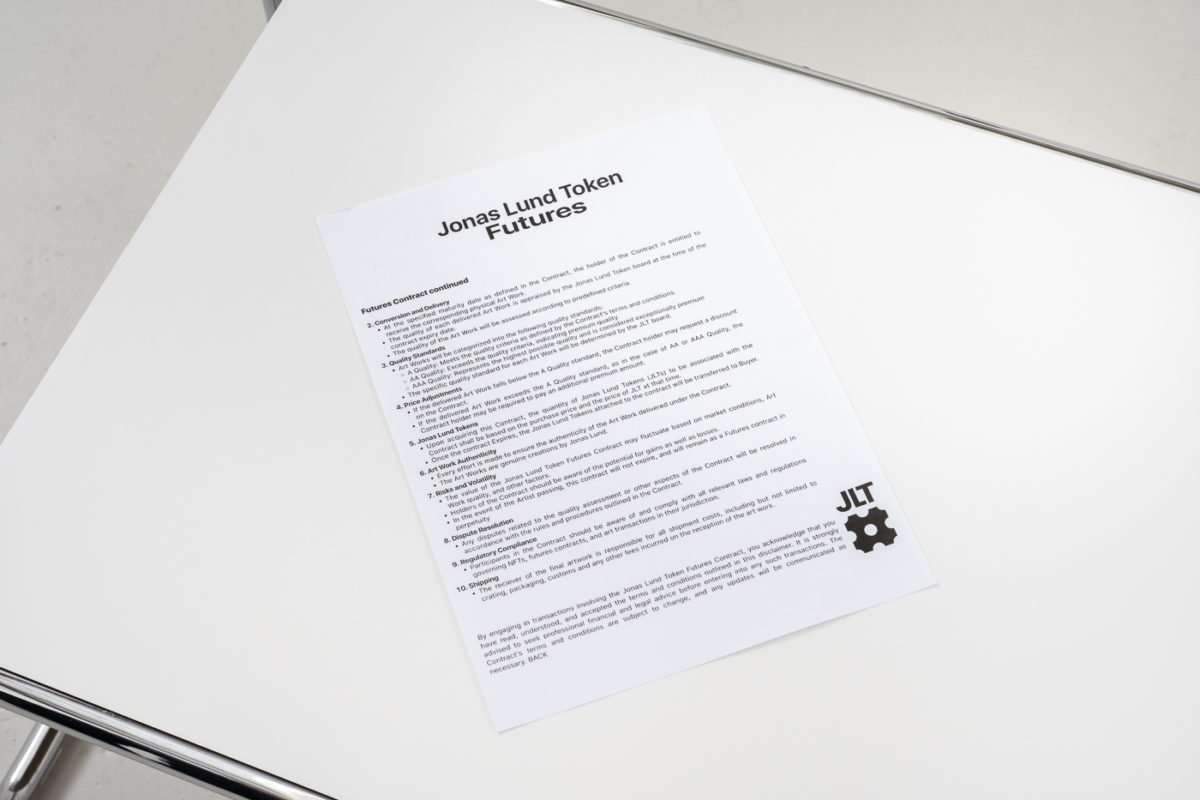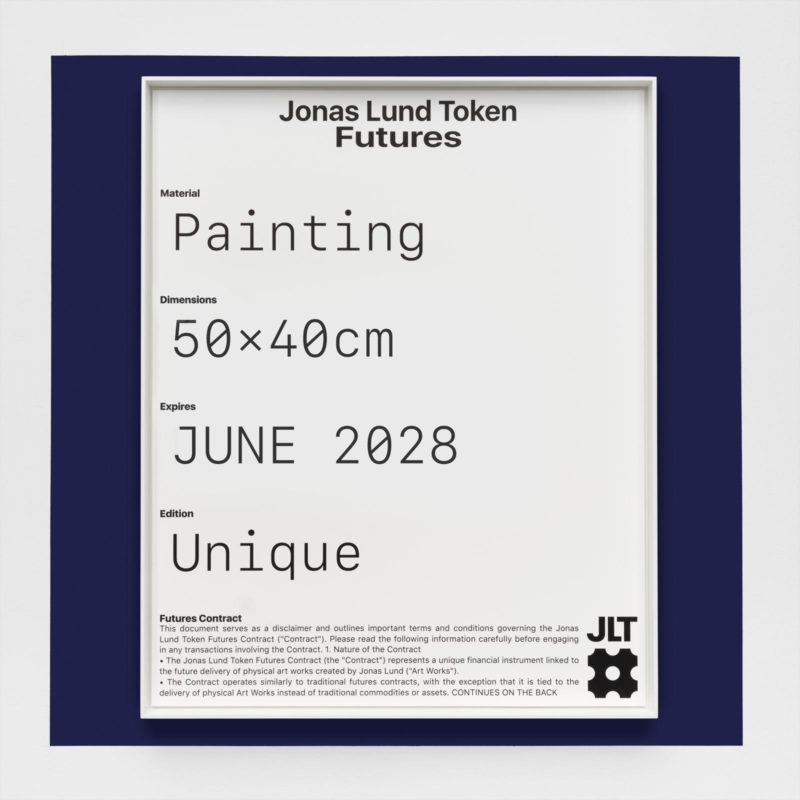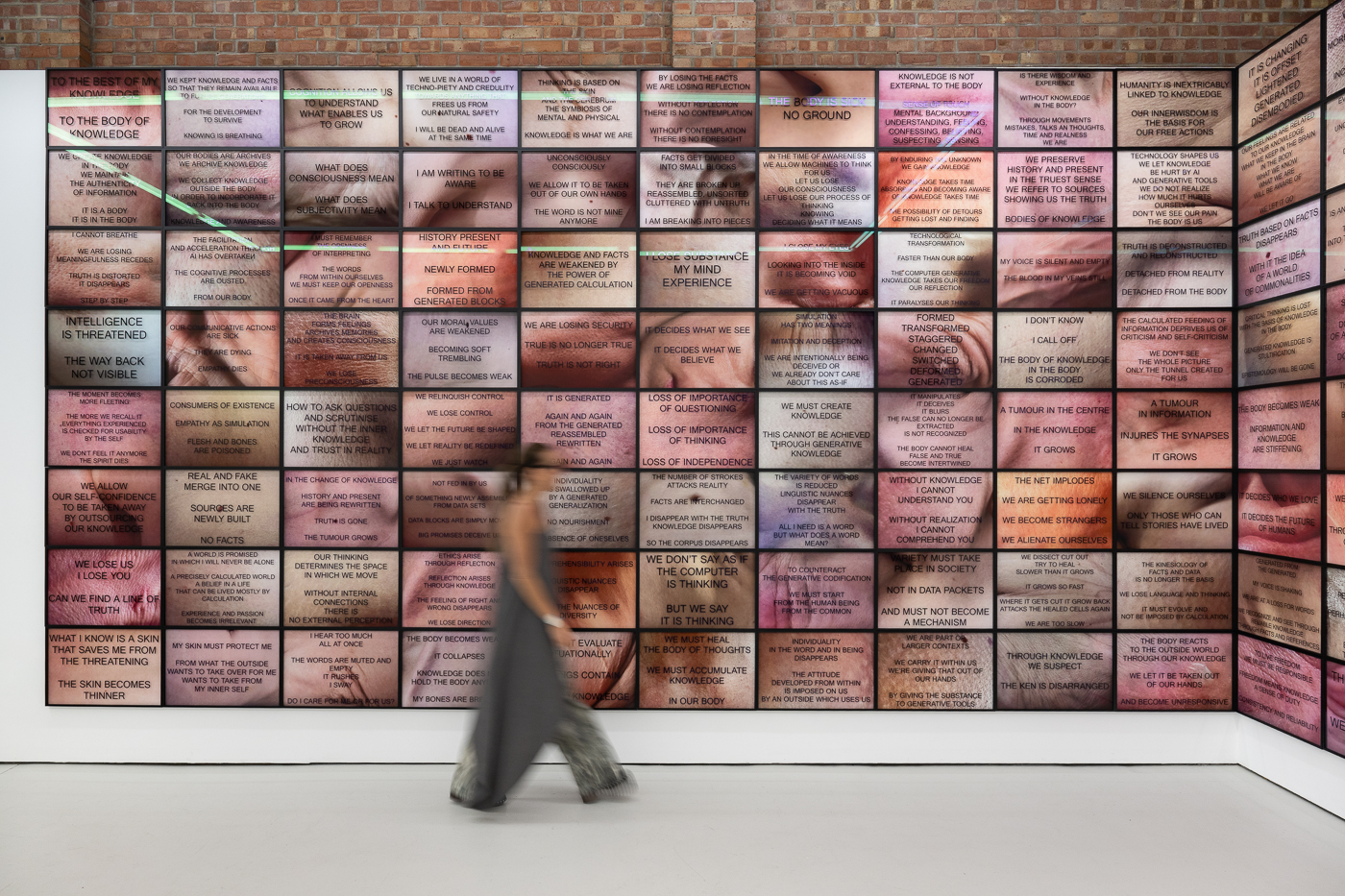
PRESS RELEASE INSTALLATION VIEWS ARTWORKS ARTIST INFORMATION VIEWING ROOM
JONAS LUND
26 JANUARY — 24 FEBRUARY 2024
OPENING RECEPTION
THURSDAY 25 JANUARY, 6–8PM

PRESS RELEASE
With a contemporary art market so geared towards incessant and rapid fire production, it’s easy to forget that the social structure that presaged it—the system of patronage—was always playing the long game. From Michelangelo’s four-year-long Sistine Chapel saga to Botticelli’s Birth of Venus, patronage popped off in the Renaissance, leading to some of the art historical canon’s most celebrated works of art.
Of course, this model also has a dark side: by controlling the final output, including its style and content, patrons—royalty, popes, empires, dictators, wealthy families—twisted art into a form of soft capital and propaganda. And yet, in an increasingly turbulent global economy, where the artist creates ceaselessly with no guarantee of making a sale, it is tempting to reconsider the collector-as-patron model and the support structure it can offer.
In the case of Swedish-born conceptual artist Jonas Lund, this model is a means of securing precious moments with his new baby: to “buy time right now with time from the future.” Leveraging the power of blockchain technologies alongside an ingenious “future proof” financial model that offers collectors the opportunity to acquire a tokenized series of works that comes with voting shares, Lund is offering his new collection of works as an investment in his future practice.
Termed “Jonas Lund Token (JLT) Futures”, this project builds on the Jonas Lund Token (JLT) project initiated in 2018 by the artist, which serves as a distributed and decentralised stewardship of Lund’s creative practice. JLT Futures launches at ANNKA KULTYS GALLERY in London with Lund’s solo exhibition, FUTURES, and the group show, Close Reading at Office Impart in Berlin. Set across ANNKA KULTYS GALLERY’s physical space and ANNKA KULTYS PHYGITAL, the gallery’s virtual reality outpost, the exhibition is the first in the gallery’s history to blend both realms. Honoring his new commitment to his son, the artist will not be physically present at the opening; instead, he will appear in the gallery space as an interactive avatar who can be approached by visitors and collectors.
At ANNKA KULTYS GALLERY London, a singular JLT Futures contract is presented, hovering over a square painted internet blue. In the gallery’s virtual space, each of Lund’s Futures presents itself initially as a printed document, gilded in a modern white box frame, effectively blurring the line between artwork and contract. With an unbounded series number, the first roster of JLT Futures on show at ANNKA KULTYS GALLERY and ANNKA KULTYS PHYGITAL will take the form of painting, but future players in the series may take the form of sculpture, video, editioned prints, NFTs, and websites.
Closer inspection of the contracts-cum-artworks exhibited within FUTURES will yield a deeper understanding of this model’s architecture. Each document indexes a unique agreement between artist and collector; details including the materials, dimensions, and uniqueness of the edition are clearly delineated. Most interesting is the contract’s expiry date: a kind of alchemical moment where each JLT Future transforms into into a physical Jonas Lund artwork.
“JLT means that I have more time now, and less time in the future, essentially I’m buying time from my future self,” the artist explains. “It also means that my future self might be quite annoyed by my current self, giving the future me more work,” he adds, semi-jokingly.
While adopting the future-leaning model of patronage, this system has clear contemporary updates. Firstly, the deliverable date is set in stone, literally written into the work’s contract. Secondly, bucking the one-to-one relationship between artist and patron, or even artist and collector, the JLT Futures ecosystem is heralded over by the JLT board, who appraises the value of each JLT Future work when it manifests as a physical artwork. Thirdly, the artist has more autonomy over each JLT Future’s final output: the collector knows the medium, dimensions, and delivery date, but that’s all the stats they’re privy to until the work is handed over. There is an element of surprise, a playful ambiguity, in what the artist will eventually receive.
Working in the long game, effectively selling a future work in the present, poses many provocations that disrupt the short term operations, speculations, and amnesia complexes that dictate the financial flow of the contemporary art market. For his part, Lund has navigated this uncertainty in equally crafty and generous measure. The price of each JLT Futures Contract is based on Lund’s current ‘market price’ at the time of purchase; following the linear logics of the market, the work will likely appreciate in value over time, translating into a good deal for the collector. But this logic depends on the belief and support that collector has in the future prospects of Lund’s practice. Purchasing a JLT Future Contract is therefore an investment within the future resilience and relevancy of the artist’s practice at large.
When it comes time to materialize, each JLT Future artwork will be evaluated by the JLT board. The works will be graded on an A—AAA quality standard, where A represents a satisfactory quality, AA an exceptional quality, and AAA embodies the highest possible quality standard. This decision is made collectively by the JLT Futures board, employing a distributive regulating logic. Finally, by not specifying many details of the work to be made, JLT Futures effectively grants the artist creative freedom to evolve over time—a JLT Future to be delivered in 2029 will be related to whatever media, topics, and methods the artist is working through at that point in the future.
Conceptual artworks that interrogate the socio-economic relationship between artist and collector through the medium of contracts are not new. Alex Strada writes contacts for her sales that require a collector to sell the work 10 years later and use the accrued proceeds to buy a piece by an emerging female artist. Rhea Myers’ Certificate of Authenticity (2020) likewise plays around with the contract format, using digital tokenisation as a means to comment on copyright and intellectual property in the post-digital era, offering 3D printable models of commonplace objects representing canonical artwork. Ryan Kuo’s ongoing project Contribution File (2016—) structures its sale not around any singular artwork but access to a Google Drive folder, shared with other collectors, where the artist uploads new works indefinitely.
The rise of blockchain-based smart contracts makes these kind of transgressive, boundary-pushing relationships easier. Yet what makes Lund’s JLT Futures model so distinctive and appealing is the deep focus on the interpersonal, despite the transactional skeleton. From the artist’s desire to push back against demanding production protocols to spend more time with his family in the present moment, to the distributed committee of JLT Collectors, Futures is a fundamentally optimistic exhibition and concept that places the human squarely in the middle of technological possibilities and creative practice.
INSTALLATION VIEWS












ARTWORKS

Jonas Lund Token Futures
2024
Inkjet print and bespoke frame
100 x 80 cm
(39 3/8 x 31 1/2 in)
Unique
(JLun015.24)

Jonas Lund Token Futures
2024
Inkjet print and bespoke frame
80 x 60 cm
(31 1/2 in x 23 5/8 in)
Unique
(JLun016.24)

Jonas Lund Token Futures
2024
Inkjet print and bespoke frame
80 x 60 cm
(31 1/2 in x 23 5/8 in)
Unique
(JLun017.24)

Jonas Lund Token Futures
2024
Inkjet print and bespoke frame
50 x 40 cm
(19 5/8 x 15 3/4 in)
Unique
(JLun018.24)

Jonas Lund Token Futures
2024
Inkjet print and bespoke frame
50 x 40 cm
(19 5/8 x 15 3/4 in)
Unique
(JLun019.24)
ARTIST INFORMATION
Jonas Lund is interested in the power dynamics framing the increasing digitalisation of contemporary culture. Working across painting, sculpture, photography, digital environments and performance, he builds systems that examine conditions of labor, agency, and authorship within automated collaborative processes. Lund engages with emergent AI models as a co-creator within his narrative worlds, provocatively blurring the line between human and machinic intelligence. Within his multilayered projects, the artist speculates on how this entwined relationship might play out within both the art market and broader social-financial systems.
Born in Linköping, Sweden, and currently based between Amsterdam and Berlin, Jonas Lund (b. 1984) earned his MA at Piet Zwart Institute, Rotterdam (2013) and his BFA at Gerrit Rietveld Academy, Amsterdam (2009).
Recent solo presentations include Annka Kultys Gallery, London (2023), Office Impart, Berlin (2023), Studio Visit: How to Make Art in the Age of Algorithms, Francisco Carolinum, OÖ Art, Linz (2022), König Galerie, König Digital, Berlin (2021), The Photographers’ Gallery (2019), Whitechapel Art Gallery, London (2016), Steve Turner, Los Angeles (2016, 2015, 2014), Växjö Konsthall Sweden (2016), Showroom MAMA, Rotterdam (2013), and the New Museum, New York (2012). Lund has undertaken prestigious residencies and commissions from institutions including the Mozilla Foundation (2021), Lima Collection, Amsterdam (2016), The Moving Museum, Istanbul, Turkey (2014), Mondriaan Fonds (2014), and Eyebeam, New York (2012-2013).
Lund’s work has been included in numerous group exhibitions including Centre Pompidou, Paris, Schinkel Pavillon, Berlin, MAXXI, Rome, HeK Basel, ZKM, Karlsruhe, Vienna Biennale, Witte De With, Rotterdam, Kindl – Centre for Contemporary Art, Berlin, Rhizome, New York, and the Stedelijk Museum, Amsterdam. The artist has been featured in international art publications including Artforum, Frieze, Kunstforum, The New Yorker, The Guardian, Metropolis M, Artslant, Rhizome, Huffington Post, Furtherfield, Wired and more.











